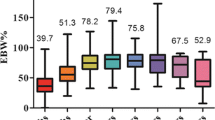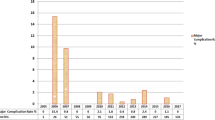Abstract
Background
Obesity has been observed to be on the rise in the Indian subcontinent. We report our early experience with the laparoscopic sleeve gastrectomy (LSG) for treating morbid obesity in the Indian population along with description of the surgical technique.
Methods
The data of 75 patients who underwent LSG for the treatment of morbid obesity at the Minimal Access, Metabolic and Bariatric Surgery Centre, Sir Ganga Ram Hospital, Delhi, from November 2006 to February 2009, were retrospectively reviewed from prospective database. The gastric sleeve is created laparoscopically using sequential firings of a linear stapling device applied alongside a 36-Fr calibrating bougie. The data collected included age, gender, initial body mass index (BMI) and excess weight, the co-morbidity status, and preoperative investigations. Perioperative parameters and follow-up details [weight, BMI, excess weight loss (%EWL), resolution of co-morbidities, and postoperative investigations] were noted.
Results
All procedures were completed laparoscopically. There was no major procedure-related morbidity. Hemorrhage requiring blood transfusion was observed in four patients. One patient died at 2 weeks postoperatively due to pulmonary embolism. There was a steady rise in %EWL from 31.2% at 3 months to 52.3% at 6 months, 59.13% at 1 year, and 65% at 2 years. Type II diabetes was resolved in 81.2%, hypertension in 93.75%, and dyslipidemia in 85% at 1 year.
Conclusion
Although long-term results are necessary to determine the benefits of the procedure, early results indicate that LSG may be a safe and feasible option for treating the morbidly obese patients.



Similar content being viewed by others
References
Deitel M. Overweight and obesity worldwide now estimated to involve 1.7 billion people. Obes Surg. 2003;13:329–30. (Editorial).
Professor Phillip James, Chair of London based International Obesity Task Force, Monte Carlo, March 17, 2003.
World Health Organization. Obesity: preventing and managing the global epidemic. Technical report series no. 894, WHO, Geneva 2000.
Misra A, Vikram NK. Insulin resistance syndrome (metabolic syndrome) and obesity in Asian Indians: evidence and implications. Nutrition. 2004;2004(20):482–91.
Dudeja V, Misra A, Pandey, et al. BMI does not accurately predict overweight in Asian Indians in northern India. Br J Nutr. 2001;86:105–12.
Christou NV, Sampalis JS, Liberman M, et al. Surgery decreases long-term, mortality, morbidity and health care use in morbidly obese patients. Ann Surg. 2004;240:416–24.
Sampalis JS, Liberman M, Auger S, et al. The impact of weight reduction surgery on health-care costs in morbidly obese patients. Obes Surg. 2004;14:939–47.
Almogy G, Crookes PF, Anthonr GJ. Longitudinal gastrectomy as a treatment for the high-risk super-obese patient. Obes Surg. 2004;14:492–7.
Regan JP, Inabnet WB, Gagner M, et al. Early experience with two-stage laparoscopic Roux-en-Y gastric bypass as an alternative in the super–super obese patient. Obes Surg. 2003;13:861–4.
Lee CM, Cirangle PT, Jossart GH. Vertical gastrectomy for morbid obesity in 216 patients: report of two-year results. Surg Endosc. 2007;21:1810–6.
Franz X, Felberbauer, et al. Laparoscopic sleeve gastrectomy as an isolated bariatric procedure: intermediate-term results from a large series in three Austrian centers. Obes Surg. 2008;18:814–8.
Wolf AM, Colditz GA. Current estimates of the economic cost of obesity in the United States. Obes Res. 1998;6(2):97–106.
Gagner M, Patterson E. Laparoscopic biliopancreatic diversion with duodenal switch. Dig Surg. 2000;17:547–66.
de Csepel J, Burpee S, Jossart G, et al. Laparoscopic biliopancreatic dicersion with a duodenal switch for morbid obesity. A feasibility study in pigs. J Laparoendosc Adv Surg Tech A. 2001;11:79–83.
Fazylow RM, Savel RH, Horovitz JH, et al. Association of super-super-obesity and male gender with elevated mortality in patients undergoing the duodenal switch procedure. Obes Surg. 2005;15:618–23.
Baltasar A, Serra C, Perez N, et al. Laparoscopic sleeve gastrectomy: a multi-purpose bariatric operation. Obes Surg. 2005;15:1124–8.
Date Y, Kojima M, Hosoda H, et al. Ghrelin, a novel growth hormone-releasing acylated peptide, is synthesized in a distinct endocrine cell type in the gastrointestinal tracts of rats and humans. Endocrinology. 2000;141:4255–61.
Ariyasu H, Takaya K, Tagami T, et al. Stomach is a major source of circulating ghrelin, and feeding state determines plasma ghrelin-like immunoreactivity levels in humans. J Clin Endocrinol Metab. 2001;86:4753–8.
Neary NM, Small CJ, Wren AM, et al. Ghrelin increases energy intake in cancer patients with impaired appetite; acute randomized, placebo-controlled trial. J Clin Endocrinol Metab. 2004;89:2832–6.
Langer FB, Reza Hoda MA, Bohdjalian A, et al. Sleeve gastrectomy and gastric banding: effects on plasma ghrelin levels. Obes Surg. 2005;15:1024–9.
Himpens J, Dapri G, Cadiere GB. A prospective randomized study between laparoscopic gastric banding and laparoscopic isolated sleeve gastrectomy: results after 1 and 3 years. Obes Surg. 2006;16:1450–6.
Iannelli A, Facchiano E, Gugenheim J. Internal hernia after laparoscopic Roux-en-Y gastric bypass for morbid obesity. Obes Surg. 2006;16:1265–71.
Silecchia G, Boru C, Pecchia A, et al. Effectiveness of laparoscopic sleeve gastrectomy (first stage of biliopancreatic diversion with duodenal switch) on co-morbidities in super-obese high risk patients. Obes Surg. 2006;16:1138–44.
Cottam D, Qureshi FG, Mattar SG, et al. Laparoscopic sleeve gastrectomy as an initial weight-loss procedure for high risk patients with morbid obesity. Surg Endosc. 2006;20:859–63.
Iannelli A, Dainese R, Pieche T, et al. Laparoscopic sleeve gastrectomy for morbid obesity. World J Gastroenterol. 2008;14(6):821–7.
Flum DR, Dellinger EP. Impact of gastric bypass operation on survival: a population-based analysis. J Am Coll Surg. 2004;199:543–51.
Flum DR, Salem L, Elrod JA, et al. Early mortality among Medicare beneficiaries undergoing bariatric surgical procedures. JAMA. 2005;294:1903–8.
Sjostrom L, Lindroos AK, Peltonen M, et al. Lifestyle, diabetes, and cardiovascular risk factors 10 years after Bariatric surgery. N. Engl J Med. 2004;351:2683–93.
Wilson LJ, Ma W, Hirschowitz BI. Association of obesity with hiatal hernia and esophagitis. Am J Gastroenterol. 1999;94:2840–4.
Langer FB, Bohdjalian A, Felberbauer FX, et al. Does gastric dilation limit the success of sleeve gastrectomy as a sole operation for morbid obesity? Obes Surg. 2006;16:1327–30.
Gagner M, Rogula T. Laparoscopic re-operative sleeve gastrectomy for poor weight loss after biliopancreatic diversion with duodenal switch. Obes Surg. 2003;13:649–54.
Deitel M. Surgery for morbid obesity. Overview. Eur J Gastroenterol Hepatol. 1999;11:57–61.
Misra A, Chowbey P, Makkar BM, et al. Consensus statement for diagnosis of obesity, abdominal obesity and the metabolic syndrome for Asian Indians and recommendations for physical activity, medical and surgical management. J Assoc Physicians India. 2009;57:163–73.
Author information
Authors and Affiliations
Corresponding author
Rights and permissions
About this article
Cite this article
Chowbey, P.K., Dhawan, K., Khullar, R. et al. Laparoscopic Sleeve Gastrectomy: An Indian Experience—Surgical Technique and Early Results. OBES SURG 20, 1340–1347 (2010). https://doi.org/10.1007/s11695-009-9973-9
Received:
Accepted:
Published:
Issue Date:
DOI: https://doi.org/10.1007/s11695-009-9973-9




